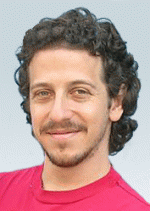Researchers from the CBU have discovered a remarkable shift in healthy people’s awareness of space as they fall asleep. In the study, published today in Nature Scientific Reports, volunteers relaxed in a deck chair with their eyes closed whilst they listened to sounds played on the left and right. The researchers measured changes in brain activity linked to falling asleep. “When they were awake, the volunteers were equally good in telling whether a tone happened on the right or the left.” said Dr Corinne Bareham, the lead author. “When they became drowsy though, they showed a dramatic increase in errors, but only for left tones. On average they wrongly indicated that nearly a quarter of left tones had been on the right. In contrast, they became slightly more accurate with right tones.”
The study, conducted at the Medical Research Council Cognition and Brain Sciences Unit in Cambridge UK was spurred by a common problem following stroke called unilateral spatial neglect. Patients with unilateral spatial neglect fail to notice information on one side of space despite in some cases being able to see, hear or feel it normally. They may eat food from only one side of the plate, wash and dress only one side of the body and even have problems in remembering details from one side of well known objects like a clock face or famous landmarks.
“It’s a highly debi litating condition,” said Dr Tom Manly, a clinical neuropsychologist on the study team, “we are interested in what makes it a persistent problem for some but not all patients, and factors that might help reduce its impact. One thing that we know is that patients who ignore the left tend to have the more severe and longer lasting problems than those that ignore the right. There is also evidence its severity is greater when patients are drowsy”. The researchers wanted to find out whether normal brains showed a similar pattern at the extremes of drowsiness. “We predicted a tiny but detectable effect,” said Dr. Tristan Bekinschtein, seen left, Wellcome Trust Fellow (and major funder of the study) and researcher on altered states of consciousness, “but we were blown away by the scale of what we found”. Whilst it is early days the result definitely raises the possibility that what we see after stroke may be an amplification of some bias in our normal awareness of space that is only revealed when we are extremely drowsy, that is changes in consciousness modulate spatial awareness. This would make us think differently about the disorder and possible treatments. Having shown that the pattern is there, the next question is why it is there and that research is ongoing.
litating condition,” said Dr Tom Manly, a clinical neuropsychologist on the study team, “we are interested in what makes it a persistent problem for some but not all patients, and factors that might help reduce its impact. One thing that we know is that patients who ignore the left tend to have the more severe and longer lasting problems than those that ignore the right. There is also evidence its severity is greater when patients are drowsy”. The researchers wanted to find out whether normal brains showed a similar pattern at the extremes of drowsiness. “We predicted a tiny but detectable effect,” said Dr. Tristan Bekinschtein, seen left, Wellcome Trust Fellow (and major funder of the study) and researcher on altered states of consciousness, “but we were blown away by the scale of what we found”. Whilst it is early days the result definitely raises the possibility that what we see after stroke may be an amplification of some bias in our normal awareness of space that is only revealed when we are extremely drowsy, that is changes in consciousness modulate spatial awareness. This would make us think differently about the disorder and possible treatments. Having shown that the pattern is there, the next question is why it is there and that research is ongoing.

 MRC Cognition and Brain Sciences Unit
MRC Cognition and Brain Sciences Unit


